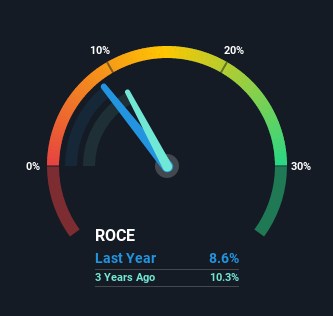UniFirst (NYSE:UNF) Will Want To Turn Around Its Return Trends
If we want to find a stock that could multiply over the long term, what are the underlying trends we should look for? One common approach is to try and find a company with returns on capital employed (ROCE) that are increasing, in conjunction with a growing amount of capital employed. Ultimately, this demonstrates that it's a business that is reinvesting profits at increasing rates of return. Having said that, from a first glance at UniFirst (NYSE:UNF) we aren't jumping out of our chairs at how returns are trending, but let's have a deeper look.
What is Return On Capital Employed (ROCE)?
For those that aren't sure what ROCE is, it measures the amount of pre-tax profits a company can generate from the capital employed in its business. Analysts use this formula to calculate it for UniFirst:
Return on Capital Employed = Earnings Before Interest and Tax (EBIT) ÷ (Total Assets - Current Liabilities)
0.086 = US$185m ÷ (US$2.4b - US$246m) (Based on the trailing twelve months to November 2021).
Thus, UniFirst has an ROCE of 8.6%. Even though it's in line with the industry average of 8.6%, it's still a low return by itself.
See our latest analysis for UniFirst
Above you can see how the current ROCE for UniFirst compares to its prior returns on capital, but there's only so much you can tell from the past. If you'd like to see what analysts are forecasting going forward, you should check out our free report for UniFirst.
What The Trend Of ROCE Can Tell Us
When we looked at the ROCE trend at UniFirst, we didn't gain much confidence. Over the last five years, returns on capital have decreased to 8.6% from 11% five years ago. Meanwhile, the business is utilizing more capital but this hasn't moved the needle much in terms of sales in the past 12 months, so this could reflect longer term investments. It's worth keeping an eye on the company's earnings from here on to see if these investments do end up contributing to the bottom line.
What We Can Learn From UniFirst's ROCE
To conclude, we've found that UniFirst is reinvesting in the business, but returns have been falling. Although the market must be expecting these trends to improve because the stock has gained 53% over the last five years. Ultimately, if the underlying trends persist, we wouldn't hold our breath on it being a multi-bagger going forward.
UniFirst could be trading at an attractive price in other respects, so you might find our free intrinsic value estimation on our platform quite valuable.
While UniFirst may not currently earn the highest returns, we've compiled a list of companies that currently earn more than 25% return on equity. Check out this free list here.
Have feedback on this article? Concerned about the content? Get in touch with us directly. Alternatively, email editorial-team (at) simplywallst.com.
This article by Simply Wall St is general in nature. We provide commentary based on historical data and analyst forecasts only using an unbiased methodology and our articles are not intended to be financial advice. It does not constitute a recommendation to buy or sell any stock, and does not take account of your objectives, or your financial situation. We aim to bring you long-term focused analysis driven by fundamental data. Note that our analysis may not factor in the latest price-sensitive company announcements or qualitative material. Simply Wall St has no position in any stocks mentioned.

